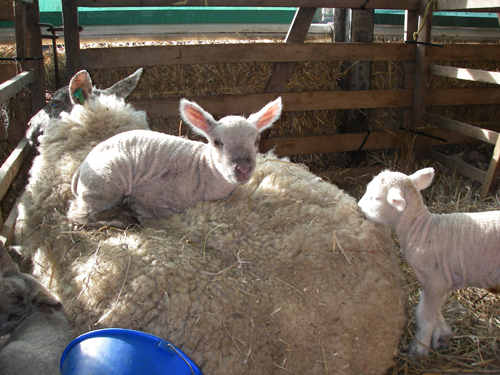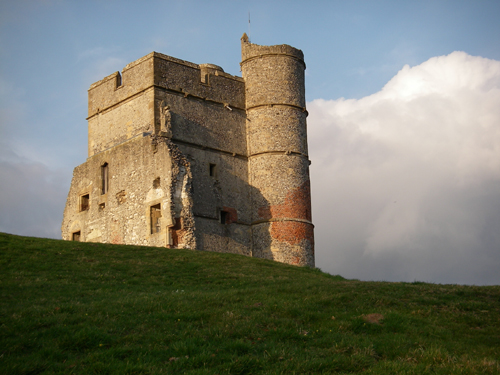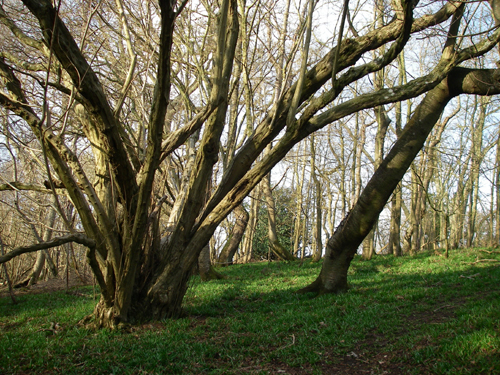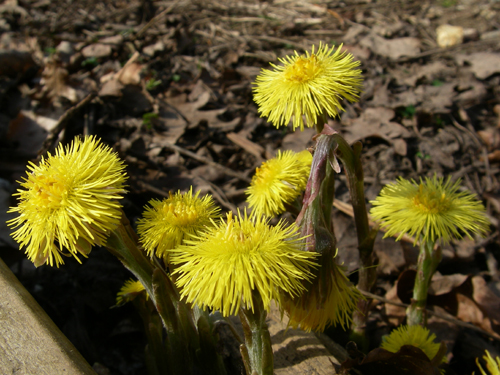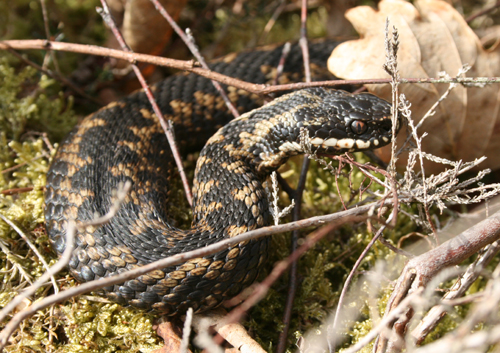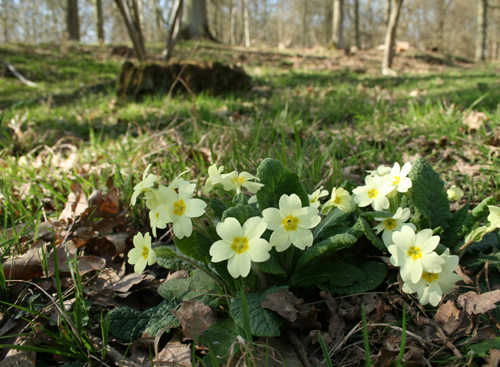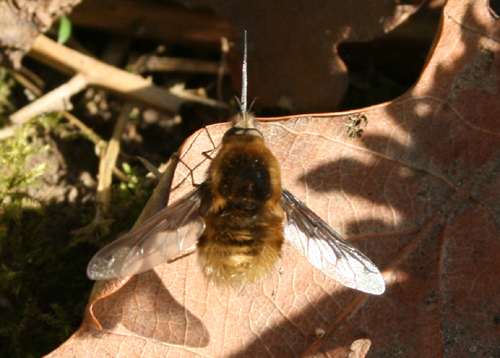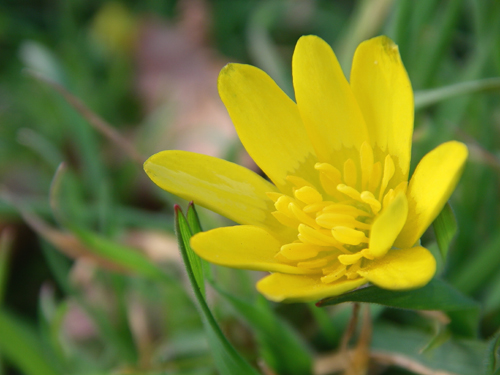It has been a few weeks since my last blog entry: part of the reason for this is shown in the photo above, i.e. it’s been lambing time at Rushall Farm. This has obviously kept the farm staff very busy, and likewise the education team – everyone wants to come for a visit during lambing time, so all the field teachers have been working flat out. Which is not say that it hasn’t been fun. I’ve had some great school groups and done a lot of striding about up hill and down dale in the sunshine. It’s been great to have become part of the regular team at Rushall, and I’ll be back there again throughout summer term too.
The preternaturally warm early spring weather lured me out on my days off work, too. I went on a pleasant trudge around Donnington Castle one Sunday in March, and explored the woodlands behind to see what wildlife was stirring (apart from a dozen or so Newbury families sunbathing on the grass around the castle itself).
Castle Wood is an ancient semi-natural woodland, a woodland with native tree species that has been there continuously since 1600 AD. Such woodlands often have high biodiversity: they are rich in plant, fungi and animal species and provide valuable habitats in the British landscape (which has lost almost 90% of its original woodland cover). As someone who has spent a not inconsiderable portion of my adult life up trees trying to stop roads being built through ancient woodlands, I am probably biased… But I do like a good old woodland to potter about in. It’s almost as much fun as rock pooling or beach combing: that same mix of wildlife discovery, striking landscape and a sense of adventure.
Ironically, it is human management of such woodlands that best conserves their wildlife value. Traditionally woodlands such as these would have been a source of timber and firewood, with some of the trees coppiced – cut down near the ground and allowed to regrow several smaller stems – on a rotation cycle, thus yielding a crop of timber but also opening up clearings and allowing flowers, insects and birds to flourish in the increased sunlight. You can see in the photo above a Hazel tree, which was probably last coppiced 50 years ago. In a ‘normal’ coppice rotation cycle, it would have been cut every 10 – 20 years, depending on what the resulting timber ‘poles’ would have been used for. Today woodland management such as coppicing is largely carried out by conservation organisations, although some land owners do harvest timber sustainably. At Rushall Farm, Joo – one of the field teachers – makes high-quality charcoal from wood sourced from the farm’s woodlands, which he sells locally. It’s always worth buying British charcoal rather than the stuff you see on garage forecourts – this is generally made from tropical forests. British charcoal burns hotter and cleaner, too.
I found this 7-Spot ladybird Coccinella 7-punctata trundling over the moss, happily prospecting for food in the mild weather. Good to see one of our native ladybird species as opposed to the now-ubiquitous Harlequin ladybird Harmonia axyridis, a species originally from eastern Asia which can out-compete and even feed on our native ladybirds. The whole ‘alien species’ issue is a hot topic in conservation and gardening circles, and rightly so: it costs conservation bodies, local authorities and environmental organisations millions of pounds each year to tackle problems caused by the spread of invasive plants and animals such as Japanese knotweed Fallopia japonica, New Zealand pygmyweed Crassula helmsii, and American Signal Crayfish Pacifastacus leniusculus. If you want to help control the problem, check out some of the links above and choose your garden plants carefully.
The warm temperatures have brought lots of spring flowers out early too: I spotted Coltsfoot Tussilago farfara beside the pond at Thatcham Nature Discovery Centre. This dandelion-like bloom always sends up its flowers with their curious scaly stems before its broad downy leaves appear. Reputedly the flowers can be brewed into a nice wine, whilst the leaves were once dried to make herbal tobacco. They have what I would describe as an apple-like scent if you crush them. The scientific name comes form the Latin tussis meaning cough: a syrup of Coltsfoot can be used to treat persistent coughing.
Cycling back from Thatcham along the towpath I came upon a whole bank of Sweet violets Viola odorata, many of the blooms the white variant of this particular species. As mentioned in my previous blog entry, I can’t get enough of violets so I lay full length on the bank in the sunshine, sniffing up their scent until my nose was anaesthetised and I had a big silly grin on my face. Luckily no-one came along the towpath at that point and found me, or they might have suspected I was under the influence of something slightly stronger than Coltsfoot wine.
It’s great to have so many peaceful and lovely natural spots within easy cycling distance of where I live. I took advantage of the continuing sunny weather to stop off for a picnic after a day’s teaching, in a secluded little spot tucked away in the reedbeds near Thatcham. Apart from the occasional distant roar of passing trains (a sound that I find quite soothing) it was basically just me and the Chiffchaffs (Phylloscopus collybita) doing their onomatopoeic thing in the willow scrub. A rye bread sandwich, a bottle of ginger beer and thou, as Omar Khayyam might have said had he been there. Which he wasn’t. So I got to drink a whole bottle of Fentimans ginger beer and eat all the posh crisps myself. Life doesn’t get much better than this.
Lest readers of this blog think I spend most of my time slacking off, I hasten to add that I have actually been working very hard over the past few weeks. One of my jobs is assisting ecological consultant Rod d’Ayala with the reptile surveys he is carrying out in the Greenham and Crookham Commons area. In particular, the surveys are aimed at identifying breeding and hibernation sites for Adders Vipera berus.
As Britain’s only venomous snake the Adder has unfairly been saddled with a fearsome reputation, but these wary creatures are very sensitive to disturbance and will usually get out of your way long before you see them. If you do something silly like trying to pick one up and get bitten, it’s highly unlikely to be fatal: the last death in the UK from an Adder bite was in 1975. If you stay on footpaths and don’t go poking around in the undergrowth on heathlands (where Adders tend to be found) then you should be safe enough. If you like to walk your dog in these areas, my advice is to keep it on a lead (which you should be doing anyway, if you’re walking through a nature reserve). As a reptile surveyor, I follow a specific route and check known locations for Adders and other reptiles, but even I find it hard enough to track them down. When I do come across an Adder I try my best to get close enough to take a clear photograph of the markings on its head and neck, as these enable us to identify individual animals and thus assess how well populations are faring on each site they are known to occur. The photograph below is of a particularly handsome and fat male I spotted on Crookham Common, curled up peacefully sunbathing in a clump of heather. Beautiful, isn’t he?
Of course I see lots of other wildlife while I’m out surveying for reptiles. On sunny days there have been quite a few butterflies about, including Brimstone Gonepteryx rhamni, Orange tip Anthocharis cardamines, Peacock Inachis io and Comma Polygonia c-album (pictured in the photo below). All of these early-flying species overwinter as hibernating adults (except the Orange Tip, which overwinters as a pupa), and consequently emerge in spring hungry for sources of nectar. You may also see them sunning themselves on south-facing banks or sheltered stretches of footpath, warming up their flight muscles ready to go searching for food. One thing that often surprises people is how territorial butterflies are: I watched a Comma sunbathing on a farm track at Rushall, where every few minutes it would dart upwards and see off any other butterflies that happened to fly past it (including a rather startled Peacock), with a rustle of flapping wings.
Whilst wandering through the woods at Rushall at the end of March I did see quite a few flowers blooming, including Primrose Primula vulgaris, Wood Anemone Anemone nemorosa and even some very early Bluebells Hyacinthoides non-scripta. Much as I love Bluebells, there is something slightly eerie about seeing them in flower in March… Climate change sceptics, please take note.
Another insect I spotted that appreciates Primroses and other spring flowers is the helpfully named Bee-fly, Bombylius major. Resembling a small bumble bee with its furry body and hovering habit, the Bee-fly also has an enormously long proboscis that it uses to feed on nectar, perching on flowers to do so. Female Bee-flies can often be seen flying low over the ground to search for tell-tale small holes marking the burrows of beetles, solitary bees and wasps. When they find a burrow they will lay their eggs in the soil, sometimes flicking them in with their legs. When the eggs hatch out they find a ready meal in the larva of the beetle, bee or wasp that was the original inhabitant of the burrow. Perhaps not the most savoury of life cycles, but I like Bee-flies: there’s something quite otherworldly about their appearance, and for me they are one of the signs of spring having truly arrived.
Sunshine and my allotment beckon, so my adventures over the Easter holidays (visiting a friend in south Wales) will have to wait until my next blog entry. I’ll wind this piece up by hoping that all of you have had a good Spring Equinox and Easter. As the hosepipe ban commences here in drought-ridden West Berkshire, I’m wishing for rain but hoping that most of it will come at night, rather than when I’m teaching school groups outdoors. Now where did I put my waterproof…

